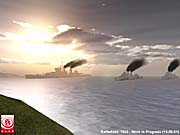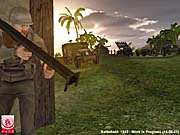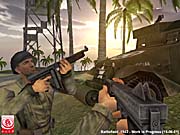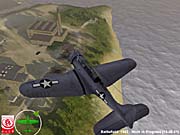Battlefield: 1942 Preview
Battlefield: 1942 lets you wage war on land, at sea, and in the air, in both the Pacific and European theaters and online with up to 64 others. Is this online multiplayer battle simulator too ambitious for its own good?
College football fans can tell you that one of the big games each year is the classic Army vs. Navy matchup. From the standpoint of pure athletic competition, the hubbub around the game doesn't make much sense--neither team is usually ranked highly, nor do many of them make it anywhere near the NFL. Of course, that's not the point. The game has essentially become the singular outlet for the rivalry between the different branches of the armed forces.

We mention this only because Battlefield: 1942 is the first console game that isn't trying to separate war into tidy pieces. Usually, if you want to pilot a submarine, plane, or tank, you must buy a sub simulator, a plane simulator, or a tank simulator, respectively. Battlefield, as the name indicates, is all-inclusive. You can control any and all elements of the Army, Navy, Marines, and Air Force. Even more impressive, you can potentially play them all on the same 3D field of play--all in the same mission. This isn't some removed real-time strategy game we're talking about, either; you can jump in a tank, then take off in a plane, fire the guns on a battleship, or run through the trenches as a grunt, seeing exactly what they see, as they see it. As you've probably figured at this point, Battlefield is a tremendous undertaking. Digital Illusions Computer Entertainment (DICE) claims it's been working on the PC game for three years now and has finally confirmed the game's simultaneous development for Microsoft's Xbox.
The year 1942 has been considered the real turning point of World War II. In Africa, Rommel's Panzers were halted on the border of Egypt by a determined British defense; in Russia, the German blitzkrieg was blunted in Russia, at Stalingrad; and in the Pacific, the Americans anticipated the Japanese attack on Midway and routed their powerful fleet with a preemptive strike. Against this dramatic backdrop, Battlefield lets you participate in four of the major campaigns that proved to be the turning point of the war. DICE promises that these four campaigns in the game (each about six missions long) take place in both the Pacific theater and in Europe and are playable from both the Axis' or the Allies' perspective.

You will have the entire World War at your fingertips, and DICE is promising that it has given the game's single- and multiplayer games equal attention. In the single-player game, you begin as a noncommissioned officer, mostly performing the kind of infantry missions you may have played in the Medal of Honor games (though Battlefield's first-person shooter grunt game is a more bare-bones representation). What makes Battlefield different is what happens as you complete your missions. Sure, you can win medals and promotions for speed and accuracy, but these rewards are mere harbingers of added responsibility. One you're promoted to sergeant, you're given control of your own platoon of men. Eventually you'll control a platoon of tanks, squadrons of planes, and even a battleship. You'll turn from being a participant in the battle to being the commander of the battlefield, dictating the action as you see fit. You'll be scheduling bombing runs, coordinating assaults, and plotting artillery strikes. Furthermore, DICE claims it's made these battles fit into a larger dynamic campaign, which changes the overall situation based on your performance. The goal is to win enough major battles to swing the course of war to your side's favor.
On the multiplayer side of Battlefield, there's a similar level of innovation and versatility in the gameplay. DICE boasts that the engine has been designed to support up to 32 players on each side. As many as 64 players in all can be playing at one time as one of six possible classes. DICE says the action will be much more chaotic than your typical 24-man game of Team Fortress. In addition to giving you six character classes to choose from, Battlefield lets you control 14 different vehicles, planes, and ships. These vehicles are modeled after the real thing, too. You can fly Mustangs, drive Shermans, T-34s, and Tigers, and pilot or play gunner on battleships and submarines. Coordination between men and vehicles is a must as well. Much like in real war, victory in the game is only possible through the use of coordinated combined arms. A Tiger tank, for instance, may dominate land, but if you don't keep Allied dive-bombers off its back, it won't be dominating for long. Likewise, you may have some crack infantry squads, but if you don't have assault guns giving you suppressing fire as they attack enemy pillboxes, they won't make it 50 feet out of the trenches.

Though not a deep simulator by any means, every aspect of WWII warfare in Battlefield will be accessible to you from a first-person-shooter perspective. DICE is proud of its graphical engine, explaining that it lets trees, buildings, and even the landscape itself get blown to pieces. Missions may begin on pastures and farmland, but after a few carpet-bombing runs and some heavy artillery splatter, expect an apocalyptic landscape with more dead elements than live ones. This isn't your typical first-person shooter. DICE seems most excited by the fact that these vehicles--not the soldiers--dominate the field. This will be the first console game to attempt this, and it should be a big change from other multiplayer games like Counter-Strike or Unreal Tournament, which are typically controlled by uncoordinated one-man armies.
The major flaw of games with large, navigable 3D environments is their limited draw distances. DICE hopes to overcome this problem in Battlefield: 1942 by using lots of scalable and deformable models. This means that a unit, building, or vegetation with 1,000 polygons up close, for example, might drop to 100 at 1,000 yards and possibly to just a few dozen at a mile. This lets Battlefield display a lot of units at once and maintain a viewable area of over 1.5 miles in any direction without slowdown. Of course, fog is still present, but it shouldn't interfere with gameplay, nor will it obscure a strategic view of the map. Vehicle and soldier models reflect a high attention to detail and realism. Infantry have a pleasant, realistically rounded appearance; you can see the expressions on the grunts' faces. Planes and tanks are accurately proportioned and easily identifiable to WWII aficionados--they even feature division and squadron markings and insignias to boot.

The primary obstacle for Battlefield, though, will be getting the game out in a reasonable time with online play intact. Microsoft hasn't let many details of its online strategy slip, which doesn't bode well for DICE meeting its Q1 2002 release without some online gameplay sacrifices being made. Three scenarios are entirely possible: One, Microsoft's online strategy will take longer to implement than originally thought, and integrating a compatible multiplayer element on the Xbox will force DICE to delay the release; two, DICE will elect to forgo compromising the game's release date and will make the Xbox version single-player only; or three, Microsoft will somehow get the Xbox community online and happy by early next year, just in time for DICE to roll out Battlefield: 1942 before spring (don't hold your breath).
Battlefield: 1942 is being developed by Digital Illusions Computer Entertainment and will be published by Electronic Arts. Look for GameSpot to have more information on this one as it nears its release next year.
Got a news tip or want to contact us directly? Email news@gamespot.com
Join the conversation